
Editor Inwood’s desire to revamp the look, feel and editorial direction of your favourite motoring magazine extended to every nook and cranny of this august organ. And so the edict to writers in this long-termers section was to step it up a level and ensure that every update has both a bespoke focus and an accompanying photographic record.
No problem: I had a brand new Hyundai Santa Fe Highlander gleaming in the driveway, and all the requisite familial accoutrements to bring to life a moment of suburban bliss. But to properly sketch this picture of clichéd domesticity, we really needed a pooch.
It occurred to me that somewhere in a long-since discarded toy box, buried beneath headless Barbies and broken fairy wings, slept Biscuit, the battery-powered pup. With a king’s ransom of D-cells wedged up his clacker, Biscuit would sit up and beg, lie down and sleep, shake hands, wag his tail, bark, whimper – basically do everything short of fetch … or crap on your floor.

Which explains the photo, but you’re probably also wondering about the car. It’s lovely, thanks, even if we did have to wait six weeks for this top-spec version (in Stormy Sea blue) to arrive on a slow boat from North East Asia.
It seems the Korean giant’s impressive new seven-seater is proving popular. And why wouldn’t it, loaded to the gills as it is with all manner of safety, comfort and convenience features, which in this trim includes a sprightly 147kW/440Nm 2.2-litre turbo-diesel four cylinder, mated to a responsive eight-speed auto. Add to that styling that looks like it’s just stepped out of the pages of European Central Casting, and both a five-star ANCAP safety rating and a five-year unlimited kilometre warranty.
If you really want to spoil yourself, this top-of-the-range diesel-only Highlander AWD costs $60,500 and boasts a list of standard kit as long as a Sydney train trip on New Year’s Eve. Options are few, but we’ve ticked the coloured leather trim and premium paint box ($695), plus the $295 Burgundy interior option which brings carbonfibre-effect inserts, and suede on the pillars, sun visors and headlining. And before you ask, no, the suede is not blue.

Styling wise, it’s a handsome beast, with a simpler, cleaner profile than its fussily folded and creased predecessors, utilising tasteful fillets of carbon-effect detailing on the grille and elsewhere. The prestige overtones carry on inside, where improvements in design and material quality are evident.
However, as you’ll see elsewhere in the COTY coverage of this issue, there were some valid questions raised about the price gulf between this Highlander and lesser variants in the Santa Fe range and as to whether a Hyundai SUV can even carry a $60K price tag.
On the exposure we’ve had to the Santa Fe thus far, I have to say my view is ‘yes’, and that on spec and visuals alone, it aces the family friendly brief.
Update 2
The Hume Highway may not be regarded as much of a driver’s road these days, but when it comes to charting a direct route from Melbourne to Sydney, there’s no better option.
There are probably also few better ways to get to know our new long-termer than to pack it to the rafters and point its nose north for some R&R.
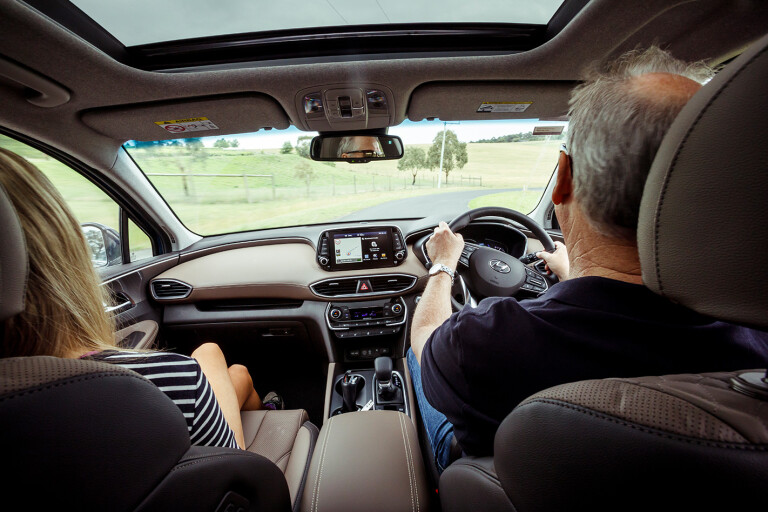
Questions are asked by the Good Wife as to why we aren’t taking the LandCruiser 200 Series that’s also parked in the driveway, which she believes will offer more luggage space and superior comfort. She’s right about the first bit, but at 547 litres, I’m confident the Hyundai SUV can swallow our four large suitcases, plus assorted summer holiday necessities.
I also back the comfort of the Hyundai’s shapely, leather-clad and ventilated buckets over the Cruiser’s more rudimentary fabric items.
As for the two rear-seat passengers, they’ll have the advantage of leather and individual adjustment and, most importantly, somewhere to plug their various iPads, pods and phones.
Given that we’ve chosen summer’s first 40-plus scorcher to travel on, the kids should also appreciate the air-con vents integrated into the centre console, the bottle holders in the doors and centre armrest, and the inbuilt sun shades on the side windows.
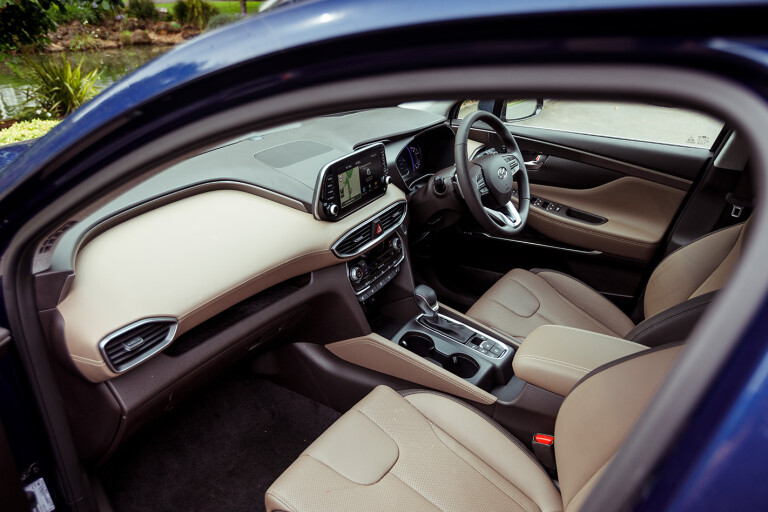
What I do need, however, is a cargo net, to ensure our luggage doesn’t Liverpool kiss the kids under braking. I find a net in the spare-wheel well, but it’s designed to secure a small load to the floor, not to act as a barrier between the boot and the second row. That’d be a handy addition, Hyundai.
Car stacked and tank brimmed, we get our motor running and head out on the highway, looking for adventure.
As the kays click by, the soaring heat – which reaches 44 degrees – tests the air-con’s capacity, but it aces that task, and the interior and ride comfort tests.
The 2.2-litre turbo-diesel is effortless; the gearing in the eight-speed auto making for an easy 1600rpm at 100km/h.
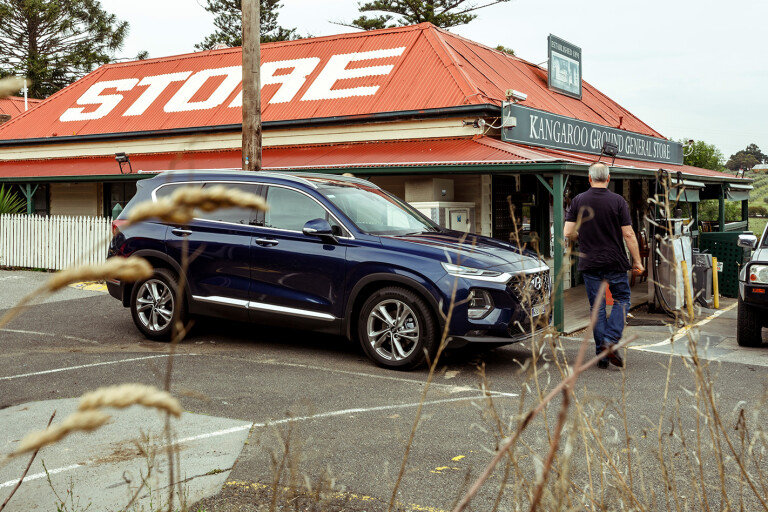
Perhaps the biggest complaint is the way the adaptive cruise loses speed up hills. There’s an unnecessary moment’s hesitation before the auto realises it needs to drop a cog or two, and in that space, 115 becomes 109km/h, or less.
That’s a problem Hamilton Hume and William Hovell would have loved back in 1824 when, with teams of horses, bullocks and servants, they took 16 weeks to chart the return overland route from Appin to Port Phillip. We managed the reverse half of that in 9.5 hours, in a good deal more comfort, and with only slightly fewer supplies.
Update 3
Brassy ’60s jazz-rock outfit Blood, Sweat & Tears sang “what goes up, must come down,” in their 1969 hit ‘Spinning Wheel’. They were right, of course, as affirmed some three centuries earlier by Sir Isaac Newton and that apple.
So it was that after several weeks of sun, surf and sand in Sydney, we succumbed to gravity and pointed the Santa Fe’s nose back towards Melbourne.
Having made our way north via the Hume’s easy-driving dual carriageway, it made sense to test the Highlander on the longer but undeniably more scenic and entertaining Princes Highway.
Steaming south, with the kids strapped in and a full load, we noticed the Santa Fe occasionally finding its bump stops on some of the road’s more prominent humps and bumps. Whether this was due to the fact we’d all put on a few extra holiday kilos, or that the coastal route is not nearly as well kept as its inland counterpart, the Santa Fe occasionally blotted its ride/handling copybook, with a roller-coaster-like moment of discomfort, before settling.
The ride is well judged for the most part, with good initial compliance. However, certain humps and depressions can catch it out, the compression feeling overly soft and the rebound a little underdone.
That aside, the nicely appointed cabin is a comfortable and pleasant place to spend a few hours, with a good driving position and handy features like a head-up display that incorporates blind-spot monitoring.
There were few complaints from the cheap seats, both daughters remaining personally cooled by their individual air-con vents and plugged into their respective USB ports. They also enjoyed ample leg room, individual back-rest rake adjustment, and enough shoulder room to render hair pulling an unnecessary exertion.
Meanwhile, as our load grew thanks to crucial souvenir purchases at every beachside town, I thanked the Santa Fe’s designers for their foresight in predicting that holidaying families would need every bit of available boot space, and designing their electric tailgate to allow packing right up to the boot lip, without the thing popping open in protest. Trust me when I say that those extra few millimetres saved your humble correspondent a good deal of blood, sweat and tears.
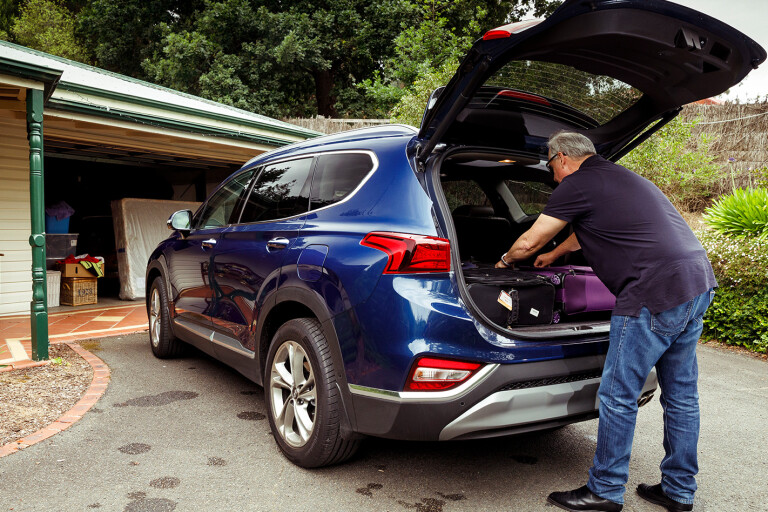
Update 4
In Stephen KING’S classic 1983 novel Christine, Arnie Cunningham’s malevolent 1958 Plymouth Fury puts the “fear into four wheels” as it goes about autonomously dispatching Arnie’s rivals in grisly ways, while driving a Cadillac-sized wedge between him and his new girlfriend.
Lately I’ve been wondering if our Santa Fe might have a touch of the Christines about it, too, in so far as there’s something suspicious about the way the heated seats and steering wheel activate with a mind of their own.
Admittedly, having your buns and palms gently roasted pales when compared to being monstered by a ton-and-a-half of angry Detroit iron, but on a hot summer day with the excellent air-con cranked to cryogenic, it’s at the very least mildly inconvenient.
The wife, too, thinks there’s something mischievous with the way the speed zones in the head-up display and sat-nav unit aren’t always in kilter with the posted limits on the road. That could be a poltergeist or other supernatural being, right?
Curbing the temptation to dial 1800-EXORCIST, we instead dial 1800-SCEPTICS, who point out that the hellfire and brimstone coming through seats and steering is likely due to the location of the switches just above the dash slot where we stow wallets and phones. Throwing stuff in there sometimes causes stray hands to bump the switch, making us feel the burn.
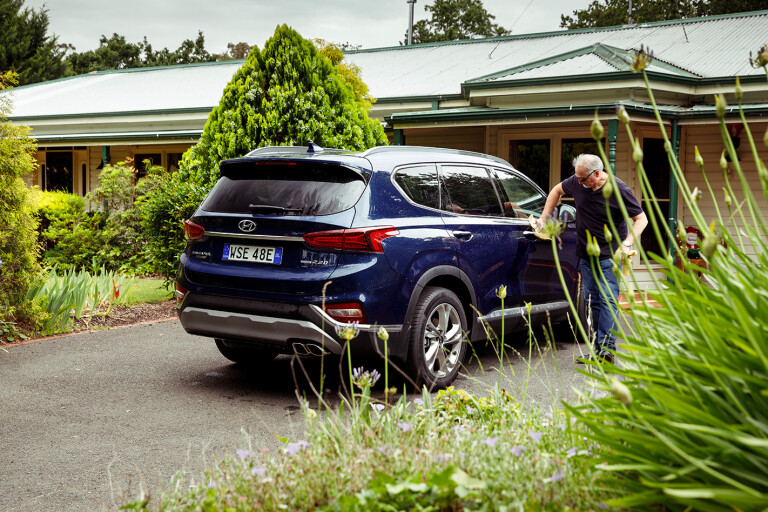
The speed limit discrepancy is also easily explained as a case of the Santa Fe’s navigation software only being updated at scheduled services, whereas VicRoads can change a posted limit anytime they fancy.
Only downwards, it seems. The wife opines that the difference between what the car says is the limit, and that of the occasional revised roadside speed sign, might be the difference between getting pinged and losing your licence. Fair call, but good luck explaining that to the judge.
When not driving the absolute wheels off the Santa Fe at a certifiably insane 80km/h, She Who Must Be Obeyed is often found in the heated and cooled navigator’s chair offering advice on anything from the standard of my driving, to the standard of my driving.
It’s then that I thank someone in Seoul for providing the handy button on the inside edge of her seat that enables the driver or rear passengers to adjust the seat fore and aft. There’s that poltergeist again, I say, as the wife’s seat glides eerily forward, until contact with the dash quells conversation.
Speaking of things autonomous, I asked someone who should know about such matters, how long Hyundai’s Lane Keeping Assist function would allow hands-free driving before alerting the driver to put a hand back on the wheel. Their response: “Oh, about 10 seconds?”
An admittedly unscientific one-Mississippi-two-Mississippi count showed a mysterious power steering the Santa Fe within its lane for a full 87 seconds before the alert chimed. Eerie, huh? It’s enough to send shivers down your spine… or did I just bump the bloody seat cooling switch again?
Update 5
For many families, the decision to upgrade to a seven-seat vehicle is taken soon after news of the impending arrival of a new addition. That third child never eventuated for us – unless you count a pampered and slightly deranged Cavoodle named Bailey – but the extra pew has always held some allure, if only for when extra kids or rellos need to be accommodated.
On the occasions when the Santa Fe’s third row has needed to be deployed we’ve found it pleasingly easy to use.
I’ve been doing this motoring caper long enough to remember the hernias and slipped discs that came with the territory (no pun intended) of some of the early third-row arrangements, including the contortionist manoeuvres required just to get back there. But when I do send our kids scurrying like spiders to the third row to make way for a friend or a grown-up, there’s only a modest amount of whingeing, easily drowned out by the Santa Fe’s 10-speaker Infinity audio system.
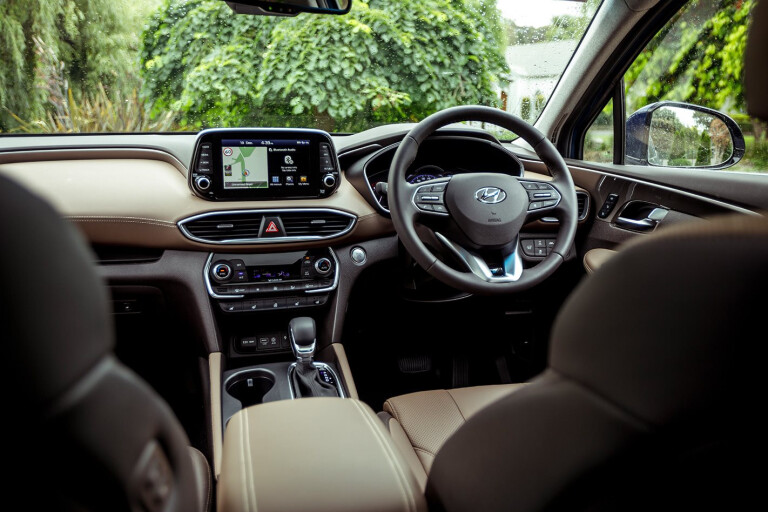
Access to the 50:50-split third row is enabled via the 60:40 split-fold second row, which collapses and slides forward effortlessly at the touch of a button. You wouldn’t direct Nana to “g’won, git back there”, but anyone short of an NBA point guard and with a modicum of spinal flexibility should be able to manage it, with a grip handle to help.
Hyundai has avoided that epic fail inflicted on us by some vehicle importers, and sited the shorter side of the split-fold second row seat on the passenger side, where you’re most likely to want to embark or disembark passengers. The presence of ISOFIX anchor points in the outboard seats of the second row is another win.
Individual air-vents for the second and third rows, and twin USB ports in the rear-centre console reduce the risk of back-seat internecine warfare.
The fact the third row folds neat and flat into the floor when not in use can’t be overstated, since we do far more driving four-up with a boot-load of luggage than six- or seven-up. Being able to use all 547 litres of luggage space without packing around humps or bumps has been medically proven to reduce dad’s blood pressure.

Update 6
I know I should be more understanding but when the call came from the Trouble and Strife that she’d run out of fuel several suburbs distant, I politely suggested she had best sort it out.
To the gal’s credit that’s precisely what she did – after providing me a character reference that might be just a tad fruity for publication – trudging a few hundred metres to collect the obligatory ‘Can of Shame’, then drizzling just enough of the life-giving liquid into the Santa Fe’s fuel neck to get it back to the servo forecourt for a thorough replenishment.

Unfortunately, some of the decanted diesel must have spilt down the inside of the fuel flap, and despite having given it a good wipe out when it eventually arrived home I’m still greeted by the waft of what Wheels veteran John Carey likes to call “dis-iesel” each time I approach the car.
When she had come off the boil a little, I calmly and condescendingly explained to the mother of my children how fortunate she was that modern diesels usually don’t require priming to restart. This is due to the fact the Hyundai and others like it run two fuel pumps; a low-pressure unit in the fuel tank, and another high-pressure unit in the engine bay, connected via a closed-loop system that always retains fuel in the lines, even if technically run dry.
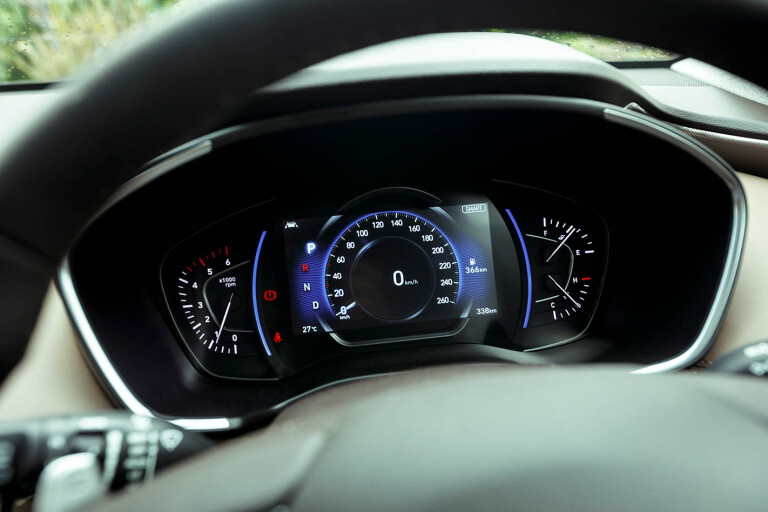
I had the pleasure of operating a bit of heavy equipment during my fickle youth, and carry some not-so fond memories of being bathed in the delightfully oily fluid while trying to pump airlocks out of the injectors of stalled graders and lighting plants.
It’s been a bit of a month for minor mishaps, actually, with the Santa Fe’s dash lights blinking a low tyre-pressure alert the other day for no apparent reason. It’s probably a result of pressure dropping due to colder weather, and the light was quickly extinguished via a visit to the servo and a few extra pounds at each corner.
The experience led me to discover that the Hyundai provides a handy graphic within the digital speedo surround that tells you precisely what pressure each tyre is at.
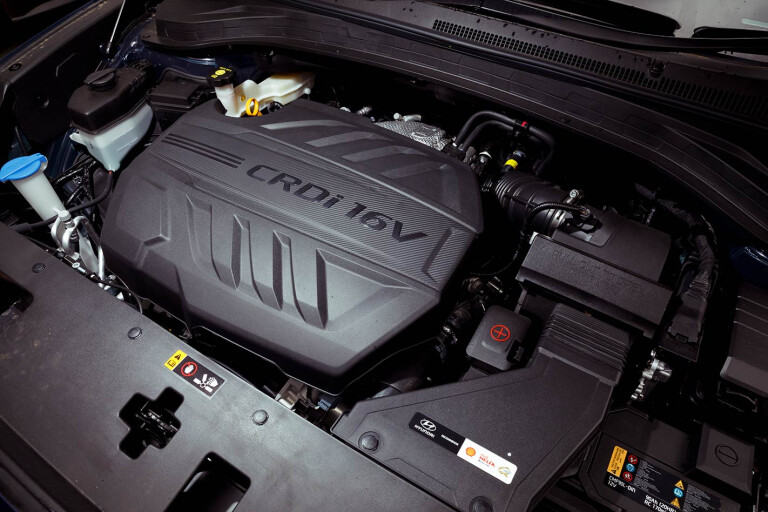
Recommended pressure for the 235/55R19 Continentals is 35psi all-round, whether laden or unladen, but they’d dropped to 31 and 32, which instigated the alert.
Now, with the tank brimmed and the hoops at their correct pressures, here’s hoping for a trouble-free final month’s motoring ahead of our wrap-up review of the Santa Fe Highlander next month.
Update 7
Did you know there are three different ways to say goodbye in Korean, depending on who leaves and who is staying?
No? Me neither, at least not until I sat down to write this farewell piece, at which point I also learned that Korean is one of the world’s oldest living languages, most likely a distant relative of the Ural-Altaic family of languages, which includes Mongolian, Finnish and Hungarian.
Why do we need to know this? Well, in order to bid our Santa Fe long-termer a culturally appropriate farewell, of course. It turns out that the correct Korean phrase for when someone (or presumably something) is leaving is ‘annyeonghi gaseyo’, the translation of which is ‘go in peace’. However, if you’re leaving and the person you’re addressing is staying, you say ‘annyeonghi gyeseyo’, or ‘stay in peace’.
Then again, you could opt for the more informal ‘annyeong’, which PSY and other cool young South Korean cats are likely to utter while lashing out on a bootload of Louis Vuitton in Seoul’s upmarket Gangnam district.
Sadly, after six months and some 8120km, there was nary a discarded $55K LV croc-skin City Steamer satchel to be found beneath the detritus of our habitation; just some muddy boots, discarded coats and something that might have once been the dog’s lunch. Either that or it was the remains of Rocko, the guinea pig, who hasn’t been seen for some time. Same thing, I guess.
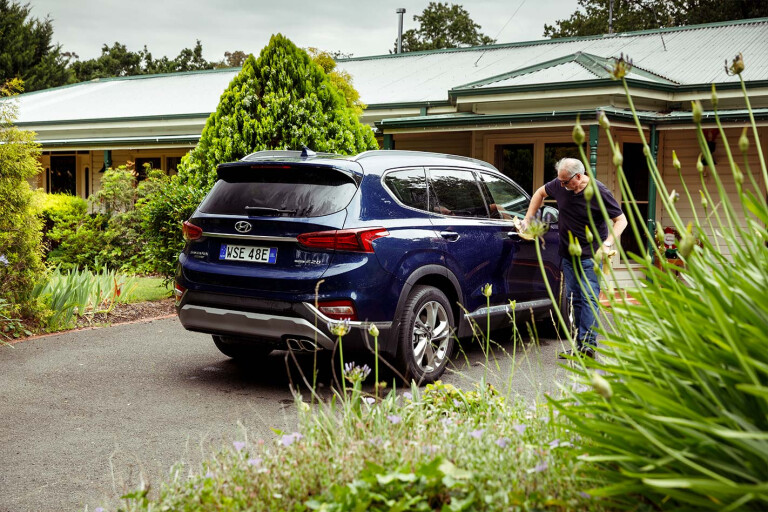
As I pulled up alongside a skip to begin shovelling out the worst of it, the kids suddenly twigged that something was afoot and the family car was about to be repossessed. Again.
It’s a curiously First World problem these kids have, in that throughout their lives they’ve never had a family car beyond the six-month mark. Not for them the gentle reflection on the dent in the side of the old Holden from where their first wheelie went amiss. No, we Bulmers enjoy a far more transient relationship with our family cars, but this doesn’t stop us making great short long-term memories in them.

Case in point, our road trip to Sydney in January, which allowed us to test the Santa Fe’s long-haul comfort and efficiency, as well as its luggage capacity and load carrying; not to mention the efficacy of its air-con in 40-plus degree heat. It passed with flying colours.
So, too, at the other end of the spectrum, where the Santa Fe toiled dutifully in the daily cut and thrust of roughly 100 school runs. Here, the sat-nav’s speed-zone alerts helped avoid many a demerit point, while its reversing camera and high-quality screen made for safer manoeuvring.
On winter mornings, Mother Duck never lost her appreciation of the fact she could open and close the electric tailgate from her heated leather seat, avoiding the shame of letting the other mothers see she was still in her ’jamas.
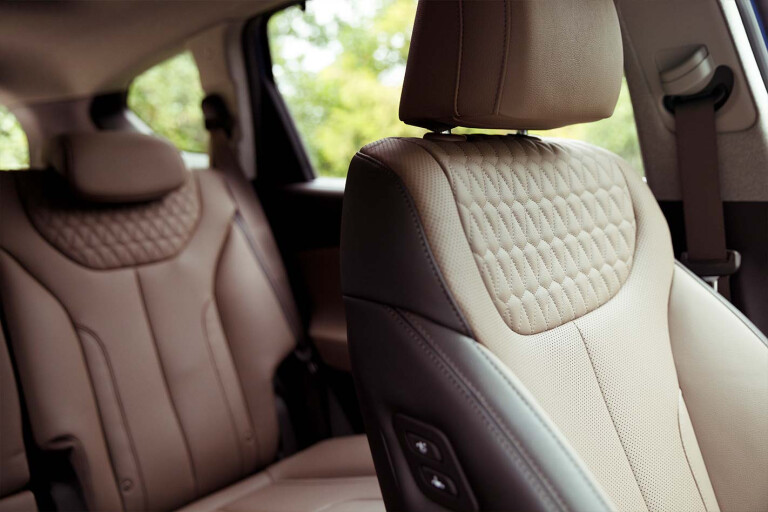
Wait, was I meant to say that?
Visits to the servo to replenish the 2.2-litre turbo-diesel’s fuel supplies were pleasingly infrequent, with consumption varying from a best of 7.6L/100km to a worst of 11.5L/100km.The trip computer indicated an accumulated average of 10L/100km, while our own math said 9.7L/100km, so let’s call it 9.9L/100km, which we think is pretty respectable for a two-tonne family SUV.
Criticisms? There aren’t many, to be honest. Some reckon it’s too expensive, but I’d point them to the level of standard features, especially the safety and driver-assistance kit, as well as the well-appointed and nicely finished interior. There were small annoyances, of course, like the sudden tugs at the wheel from the standard lane-keep assist, or the fact that the cruise control allows a bit too much speed to wash off on hills, or that you can inadvertently turn the seat heaters on by bumping them. Which is not great in summer.
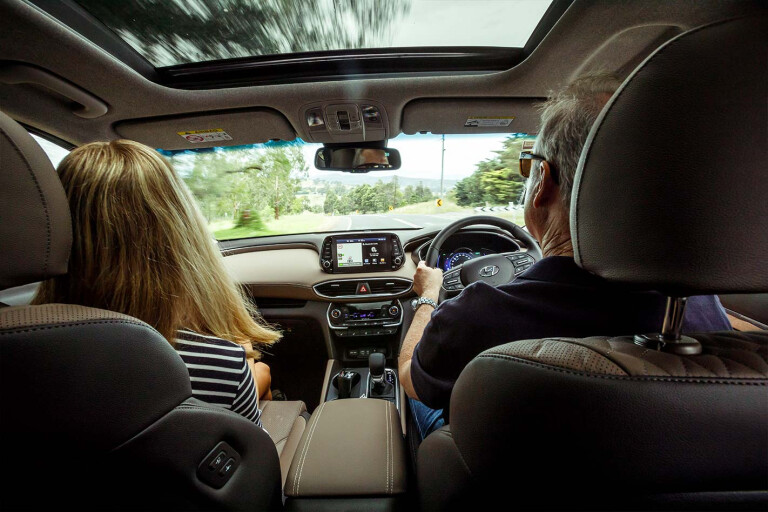
But these are minor criticisms of what is really a terrific family SUV, one that easily accommodated our family of four in safety, comfort and style for half a year of haulage.
We’ll miss having the Santa Fe in our driveway and our lives, but we’ll always have the fond memory of it, as well as a new-found mastery of ways to say goodbye in Korean, when next we dine out on bibimbap or bulgogi.

COMMENTS